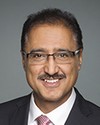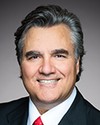Thank you, everyone, and good afternoon. Thank you for inviting me once again to talk about our long-term infrastructure plan. It's nice to be back. I'm joined by my staff members, who will assist us in the presentation and in answering the committee's questions.
I know that you have been hearing from many different organizations and people including the Parliamentary Budget Officer in doing your study. I want to thank you for conducting this study, because it's going to help us understand the importance of infrastructure.
I'd like to address some of the concerns that have been raised during those presentations.
During the Parliamentary Budget Officer's appearance, the committee asked about the risk and history of lapsed funding. Let me assure all of you that infrastructure funding does not lapse. Money that goes unspent in a given year is re-profiled to future years to ensure that it remains available for the projects and the programs to which it's allocated.
Our partner organizations know and understand this, and you have heard from some of them. The FCM, FQM, and the Association of Municipalities of Ontario all noted that they are not concerned about how federal funding flows to projects. They did, however, note the quickness with which bilateral agreements are being signed, considering the complexity. They know that as soon as decisions are made, projects can start immediately.
When we were developing our investing in Canada infrastructure plan, we worked in very close collaboration with those organizations, as well as with our provincial, territorial, municipal, and indigenous partners. From these consultations came our plan, designed to help grow the economy, build inclusive communities, and support a low-carbon green economy.
Our plan is being rolled out in two phases and delivered by 14 federal departments. The first phase involves 34 programs and is $14.4 billion. All of these programs are now launched, and more than 28,000 projects have been approved, for a federal investment of more than $11 billion.
Let me give you a few examples of what this means for our communities.
Aboriginal head start is an important program that focuses on childhood development for first nations, Inuit, and Métis children and their families living off reserve. Under the first phase of our plan, 100 sites across Canada have completed projects that enhance accessibility, health, and safety, provide outdoor learning opportunities, and address special needs. More than 4,000 children and their families are benefiting from these investments, gaining knowledge of their indigenous culture and language in spaces that are healthier and have access to up-to-date learning tools.
In New Brunswick, federal investments through Natural Resources Canada have helped to create the province's first electric vehicle charging network. Electric vehicle owners are now able to drive worry-free while helping to reduce our carbon footprint.
In Vancouver, more than 40% of the SkyTrain's stations have now been outfitted with radio frequency identification technology, allowing customers who are physically impaired to pass through the fare gates unassisted.
In Edmonton, my home city, recent upgrades to Balwin Place provide 25 much-needed new affordable housing spaces to support our most vulnerable citizens. These spaces represent a safe haven and stability for families, providing them with the opportunity to be a student and learn, to be a neighbour, to find work, and to connect with the community.
While supporting these early projects, we're working closely with our partners to develop a long-term plan to support large-scale projects that require longer timelines to plan and design. My department is now working closely with our partners to sign the bilateral agreements that will flow $33 billion over the life of this plan.
Employment and Social Development Canada has signed almost all of its bilateral agreements with provinces and territories under the $7 billion early learning and child care program.
I'm also proud to say that today Minister Duclos signed the first ever housing strategy, long-term housing agreement with the Province of Ontario. Transport Canada has launched its $2-billion national trade corridors fund and is reviewing more than 100 project applications from across Canada.
As you have heard from the mayor of Edmonton and chair of the Big City Mayors' Caucus, Don Iveson, we listened to municipalities. We value local government as partners, and they know that. By investing in improved transit services, we are giving families more time together. By investing in upgraded water treatment facilities, we are giving parents peace of mind that the water their children drink is safe. By investing in affordable housing, we are giving women and children fleeing domestic violence a safe place to live.
We're eager to build on our successes, and continue to invest in the infrastructure projects that will make real differences in the lives of Canadians from coast to coast to coast.
Thank you so much for having me.





